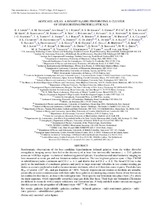Herschel-ATLAS: A binary HyLIRG pinpointing a cluster of starbursting protoellipticals
Abstract
Panchromatic observations of the best candidate hyperluminous infrared galaxies from the widest Herschel
extragalactic imaging survey have led to the discovery of at least four intrinsically luminous z = 2.41 galaxies
across an ≈100 kpc region—a cluster of starbursting protoellipticals. Via subarcsecond interferometric imaging we
have measured accurate gas and star formation surface densities. The two brightest galaxies span ∼3 kpc FWHM
in submillimeter/radio continuum and CO J = 4–3, and double that in CO J = 1–0. The broad CO line is due
partly to the multitude of constituent galaxies and partly to large rotational velocities in two counter-rotating gas
disks—a scenario predicted to lead to the most intense starbursts, which will therefore come in pairs. The disks have
Mdyn of several ×1011M , and gas fractions of ∼40%. Velocity dispersions are modest so the disks are unstable,
potentially on scales commensurate with their radii: these galaxies are undergoing extreme bursts of star formation,
not confined to their nuclei, at close to the Eddington limit. Their specific star formation rates place them 5×above
the main sequence, which supposedly comprises large gas disks like these. Their high star formation efficiencies
are difficult to reconcile with a simple volumetric star formation law. N-body and dark matter simulations suggest
that this system is the progenitor of a B(inary)-type ≈1014.6-M cluster.

